December 31, 2011
Could be host to habitable planets
Star Astronomy News
 Photo courtesy of NASA Photo courtesy of NASA
Binary star systems – Astronomers taking part in the human journey to the beginning of space and time have found star systems the human mind never imagined out among the stars. In fact, they have found that star systems with multiple stars are more common than star systems with a single star, like our own solar system. Star systems with multiple stars of varying sizes have also been viewed during the human journey to the beginning of space and time. Multiple stars that, according to present planet formation theories, could have bodies orbiting them might be found in the years ahead in our own stellar-backyard.
Binary star systems are composed of two stars orbiting one centre of mass, which is determined using the combined mass of all of the objects in the star system. Binary star systems also typically orbit each other in close orbits. Astronomers studying binary star systems have made note of an interesting fact recently. They have viewed unexpected clouds of dust orbiting distant binary stars, which they believe could be the result of collisions between bodies orbiting the binary stars in question. This has raised questions in the minds of astronomers concerning the possibility of life surviving on any habitable planets that might be orbiting binary stars in close proximity.
You see present astronomical theories concerning the possibility of binary star systems forming planets indicate this could be possible. Recent discoveries of exo-planets circling distant suns being the best evidence to date. It's even possible there could be planets circling stars in binary star systems capable of supporting human life, or life of some kind. Astronomers viewing clouds of dust orbiting binary star systems believe survival could be difficult for any life forms that might evolve on planets circling stars in binary star systems. Life forms capable of evolving and surviving on such planets would also likely be unlike anything humans have ever experienced.
Presently, astronomers are studying a class of binary star systems, named after the prototype star RS Canum Venaticorum. Binary star systems in this class orbit each other at a distance as close as 3 million kilometres. The stellar winds created by the magnetic fields of close orbiting stars is thought to be a force which would create havoc in the orbits of any planets circling binary star systems of this class. Astronomers believe this would mean any present dust clouds viewed are younger in age, since any older dust clouds would have been blown away by the constant stellar winds created by the stars. This makes it logical to assume that any dust clouds viewed are from more recent collisions between bodies orbiting stars in binary star systems in this class.
The above facts seem to paint a picture of the late stages of planet formation in binary systems in this class, according to astronomers. A bleak picture of a possibly chaotic, violent and short lived future for any lifeforms lucky enough to evolve on planets circling binary star systems in close proximity.
Posted by Warren Wong. Posted In : binary star systems
July 3, 2011
Green Lantern's emerald ring beams across space and time 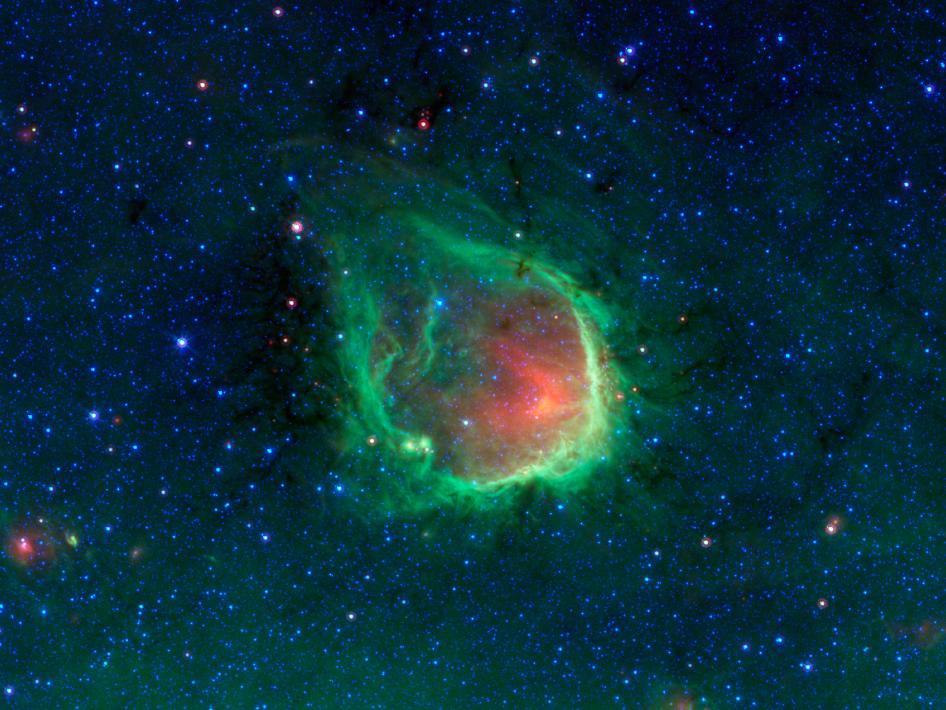
Visitors from the stars have often been the main characters in myths, legends, comic book adventures and books and movies created by humans throughout the ages of mankind. Considering the diminutive knowledge humans have of space and time this choice provides the perfect context for adventure and the unknown. The Green Lantern is one of the most popular and beloved DC Comics heroes of all time and more recently a full length feature film starring Ryan Reynolds, Blake Lively and Peter Sarsgaard. The original Green Lantern Alan Scott was created by writer Bill Finger and commercial artist Martin Nodell for All American Comics #16 (July 1940) edition. Since this time the Green Lantern alias has been shared by several DC Comics superheroes and fictional characters that have all contributed to the popularity of this timeless character.
Astronomers on the leading edge of the human journey to the beginning of time and space recently glimpsed this emerald nebula using NASA's Spitzer Space Telescope. Reminiscent of the emerald ring wielded by the Green Lantern, this emerald ring wasn't forged by the Guardians of the Universe as the power rings of the Green Lantern Corps were in the original Green Lantern adventures. Astronomers viewing scenes like the one in the picture above believe emerald nebula like the one seen here are in fact born in the fire of the most massive stars astronomers have viewed on the human journey to the beginning of the universe O type stars. This particular emerald nebula lies deep within clouds of hot gas and glowing dust in the constellation Scorpius and has been given the name RCW 120 by astronomers. The green ring we see is in fact glowing in infrared colours our eyes aren't designed to view, but using the infrared detectors of the Spitzer Space Telescope astronomers can produce images like this one.
The green ring viewed here was actually carved out by the intense ultraviolet radiation of a couple of giant stars near the centre of the nebula. The giant stars will be obscured by the light from the other stars nearby, when viewed by the infrared detectors of the Spitzer Space Telescope. Ring nebula like this one have actually been a common sight on the human journey to the beginning of space and time, so common that professional astronomers have asked amateur astronomers to take part in the search for ring nebula. People interested in taking part in the search for ring nebula should contact the people in charge of The Milky Way Project, at http://www.milkywayproject.org/.
Posted by Warren Wong. Posted In : ring nebula
April 26, 2011
The results of NASA's 18th Annual Great Moonbuggy Race and American schools were once again beaten by racers from the University of Puerto Rico in Humacao and Teodoro Aguilar Mora Vocational High School Team II of Yabucoa, Puerto Rico for the second straight year. The closest American team was the team from the University of Alabama in Huntsville, who finished second in the college division competition, while a number of American teams placed third in the competitions.
You can bet this has the American teams thinking about what they can do different next year to win and beat the Puerto Rican schools. American has had a reputation for not promoting mathematics and science enough during the last few decades and this could be coming back to bite them. The current administration better get to work on improving the level of education in the sciences during the decades ahead, or this trend could continue to be the norm.
The 18th Annual NASA Great MoonBuggy Race challenges students from all over world to compete and design and engineer lightweight, human-powered buggies demonstrating the same spirit that allowed mankind to go to the Moon forty years ago. This year over 70 different teams from schools around the world competed to see who could build the best moonbuggy and build new relationships that will help the young scientists of the world pull down barriers and work together in the battle to take mankind to the next pinnacle.
Science is the answer to many of our problems on Earth and we need to educate and energize the younger generation to find solutions to the problems they'll be facing in the future. We won't always be here to help them and one day they'll be running the show and country, and we need to make sure they have the skills, education and energy to get the job done. Talk to your children about science and mathematics and let them know that they need to make sure they get a good education in these areas, if they want to succeed in the future and solve the problems they see before them.
Posted by Warren Wong. Posted In : NASA's 18th Annual Great Moonbuggy Race
April 1, 2011

Women like Andrea Meyer are part of a new breed of women taking their place in the annals of space history and the human journey to the beginning of space and time. A breed of tough minded, can't-keep-me-down individuals use to people telling they have no chance of success, women like Andrea are big believers in the saying everything happens for a reason. This tough minded lady survived a plane crash years ago that sent her down the path to becoming the program analyst in the Office of the Chief Financial Officer at NASA Kennedy Space Center and she has never looked back.
Today, Andrea Meyer has turned her love of flying and aviation into a life that would certainly be the envy of many a young woman looking for her road to success. Picking herself up from the ashes of a plane crash that would have killed most people, this lady of NASA is today a role model millions of aspiring women across the United States of America, who look at her as an example of just how far and much women and people can accomplish when they keep their head up and eyes going forward.
Posted by Warren Wong. Posted In : The women of the American National Aeronautics and Space Administration
March 16, 2011

A career in the American National Aeronautics and Space Administration opens doors to a world of exploration and discovery more and more people from around the world are deciding to enter every year. Women and men around all corners of the globe come to NASA to join in the exploration of the universe and the world around us and try to delve deeper than their predecessors into the mysteries surrounding us.
This series of articles is on the women of NASA, their journey from an inspired young woman to the scientist they're today, and their current contributions to the work at NASA. In the hope to inspire more young women of the world to take up the torch of discovery and exploration and continue the human journey to the beginning of space and time. A journey that started with women astronomers like Sumerian poet and the high priestess of the moon goddess Inanna, Enheduanna, who was born in the year 2300 BCE.
QuynhGiao Nguyen started her journey to becoming a NASA scientists from her home country of Vietnam at the age of 7, when she immigrated to America. Her first few years in the United States were spent getting use to her new life in a foreign country and learning the English language.
Falling in love with the science of chemistry, QuynhGiao started her first internship at the age of 19, and eventually earned her PhD in Clinical-Bioanalytical Chemistry from the Cleveland State University College of Science. Today, QuynhGiao works as a materials scientist evaluating high-temperature materials for aircraft and re-entry vehicles for NASA, and currently is working with the Space Flight Systems Directorate in the Exploration Technology Development and Demonstration Program office.
Posted by Warren Wong. Posted In : The women of the American National Aeronautics and Space Administration
November 27, 2010
Astronomy for Kids
Question Period

What's the ultimate fate of our sun? How will the sun end its days?
The ultimate fate of our sun, like all of the stars in the Milky Way, is tied to its life cycle. The two main processes astronomers theorize in the life cycle of our sun as being mainly responsible for the ultimate fate of our sun being the fusion of lighter elements into heavier elements and the loss of the sun's mass in a second process that begins after the first is completed.
At present our sun is going through the first process of the two processes astronomers believe determines the ultimate fate of our sun, the fusing of lighter hydrogen nuclei into heavier helium nuclei. This process results in the release of energy into the solar system and is ultimately necessary for life to have started on Earth and to continue until the present day. During this process four hydrogen nuclei are fused into one helium nuclei, which results in the direct production of solar energy due to the fact that four hydrogen nuclei weigh less than one helium atom. The extra mass of the four hydrogen nuclei is converted to energy according to Einstein's famous equation energy= mass x (speed of light) x (speed of light), or E=m(c x c).
The first phase of this helium building process will continue for the next five billion years, or so, until about 10 percent of the mass of hydrogen at the center of our sun is converted to helium. At this time, the core of the sun will begin to contract and the process of converting hydrogen into helium will start again in another shell outside of the shrunken core of the sun, while the outer layers of the sun will respond by expanding to several times the sun's current size. The core of the sun will still be obtaining the energy released by the sun at this time by continuing to fuse four hydrogen nuclei into one helium nuclei, until about 50 percent of its mass has been converted to helium.
Once the sun has reached this phase of its life cycle the core of the sun will begin to switch from converting hydrogen into helium, to fusing helium into carbon and oxygen. After all of the available helium of the sun has been converted to oxygen and carbon, astronomers believe the core of the sun will once again begin fusing hydrogen into helium in another shell, until the second process astronomers believe ultimately determines the fate of our sun begins, the loss of the sun's mass.
Before this second phase of the sun's life cycle starts the sun will have reached several thousand times its current luminosity. During this part of this second phase of the sun's life cycle the sun will become unstable and begin to pulsate. It will begin to shrink and expand within a time period of about one year and become what astronomers refer too as a Mira variable. This shrinking and expanding of the sun produces compression waves in the sun's atmosphere and results in the eventual expulsion of a significant volume of the sun's mass into space.
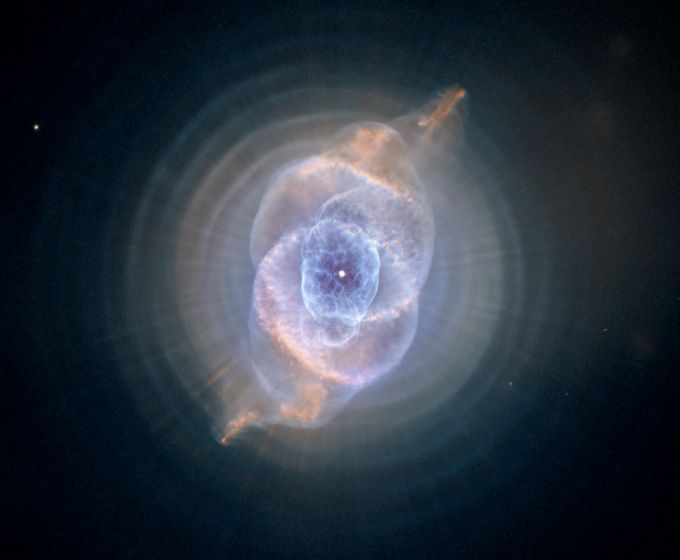
Posted by Warren Wong. Posted In : the sun
November 23, 2010
September is one of the year's most entertaining and awe-inspiring months to lay on your back on a dark hill and view the delights of the celestial dance in the sky above you as your ancestors once did on a nightly basis. Four of Sol's dance partners will be in the spotlight in September, 2010, taking part in a nightly dance that includes their less observable brothers and sisters, while Mercury will once again dance privately in the eastern sky each morning during September.
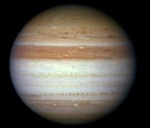 - Mighty Jupiter rules the night sky in September 2010. NASA photos.
Mighty Jupiter will rule the night's sky in the Northern Hemisphere during September, especially after he reaches the point in his orbit opposite the sun as seen from SpaceshipEarth1, which space scientists call Jupiter's opposition. This celestial event will occur on the last day of summer in the Northern Hemisphere, on this day the 24 hour period of the day will be evenly separated into night and day, and the evening temperature will still be warm enough to make star-gazing comfortable. The perfect time to set up your celestial time machine to the stars or to just lay back on the cold Earth and watch the celestial dance above you unfold before your eyes as millions of your ancestors have since mankind first perceived the possibilities the night's sky creates in the human imagination. This will be the most comfortable and best time to view Jupiter in the past 47 years and it will definitely be more comfortable viewing than during Jupiter's next opposition on October 29, 2011. During Jupiter's opposition on October 29, 2011, the weather will be a lot of colder than on September 21, 2010, and you'll have to wait another year to have a look at the largest planet in our solar system.
Mighty Jupiter will be at his brightest when he reaches opposition on September 21, 2010 and on this night the King of Sol's planets will shine brighter in the night's sky than during anytime in the past 47 years. Jupiter will also appear bigger during its September 21, 2010 opposition, subtending an angle of almost 50 ", and shining at magnitude 2.9. This means that after Venus sets at around 8 P.M., mighty Jupiter will be the brightest star like object in September's night sky.
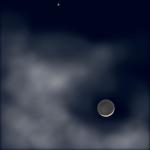 - Venus fluctuates in visible size in September
Mighty Jupiter will travel near the border between the constellations of Aquarius and Pisces for several months on both sides of opposition. This region of space-time has few bright stars to outshine Jupiter and the contrast allows viewers to get a good look at Jupiter. The nearest 1st magnitude star, Fomalhaut (Alpha) Piscis Austrini, is over 30 degrees away and mighty Jupiter is easily observed in the night's sky at this time.
Star gazers in the mid-northern latitudes will find that due to their location mighty Jupiter only climbs halfway up the night's sky in September, 2010. This doesn't make for the best viewing during Jupiter's opposition and Jupiter's altitude will be at its greatest at local midnight time. Star gazers at latitude 40 degrees north will therefore see Jupiter at 48 degrees above the southern horizon. In the northern hemisphere of Earth, star gazers will view Jupiter 1 degree higher in the night's sky, for each degree of latitude south of 40 degrees north at which they're viewing Jupiter. In contrast, for each 1 degree north of 40 degrees north at which you observe Jupiter, you'll see Jupiter 1 degree lower in the night's sky.
Star gazers that want to view mighty Jupiter as he dances across September's night sky can so so without a pair of binoculars. Star gazers will need a pair of binoculars or telescope to see Uranus, Sol's seventh planet will lie within 2 degrees of Jupiter throughout September, and can be difficult to view Uranus at this time. Sol's eighth planet, Neptune, will be found about 30 degrees west of Jupiter and Uranus during September. Star gazers that want to view Venus and Mars should look in the evening twilight near Virgo's brightest star, Spica.
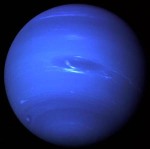 - Neptune can be found 30 degrees west of Jupiter and Saturn in September's night sky
We'll begin our journey across September's night sky during the first week of Earth's ninth month, at this time Saturn will be dancing in the twilight of the low horizon of September's night sky. We'll board our time machine to the stars and planets on September 1 and start the first leg of our celestial journey to the beginning of the universe in human terms by traveling across space and time to Saturn. Sol's ringed planet will set an hour after the sun on this day and can be found dancing in the sky about 5 degrees above the horizon, after the sun goes down.
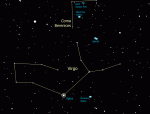 - Venus and Mars can be found dancing in the evening twilight close to Spica in the constellation Virgo
To locate Saturn, use Venus as your visual guide. Earth's evening star will be visible a few minutes after the sunsets. Look for Spica in the constellation Virgo, to the right of Venus. Saturn and Spica glow at the same relative magnitude, so if you take your time and can find Spica, you should be able to see Saturn in the night's sky above you. Saturn will be found 20 degrees to the right of Venus in September's night sky and at around half the distance from the horizon as Venus. Saturn will continue to be viewable from Earth, throughout the first week of September, 2010, and viewing Saturn from SpaceshipEarth1 will become increasingly difficult after this time.
On September 1, 2010, Venus will be dancing in the night's sky in line with Spice and Mars. Spica will be in the middle of this dance, and if you continue to watch this celestial dance unfold for two more nights, Spica will dance toward the center of the trio. The trio will begin to fallback from each other as September enters the second week and will form an ever-widening triangle. Venus will shine the brightest during this celestial dance across September's night sky, while Spica will outshine Mars as the trio does their nightly dance across the skies of September.
On September 10 a crescent moon will join this celestial dance. Mars will be viewable about 6 degrees above the Moon, while Venus will be to the lower left of Mars. Continue to watch this dance unfold and you'll see the Moon travel 6 degrees to the left of Venus by the time September 11, 2010 arrives. The Moon will also grow in visible size each night after September 11, 2010, until reaching full moon at 5:17 A.M. EDT on September 23.
Venus will continue to be viewable in September's night sky as she dips closer to the horizon each night during September. Venus will shine her brightest on September 23, 2110, when the evening star will shine at magnitude 4,8 and will set an hour after Sol retires for the night. Watch Venus during this time and she'll draw you into her nightly dance and fascinate you as she goes through obvious changes in visible size and phase. View Venus on September 1 and you'll see a planet with a disc 29 " across and at 41 percent illumination. By the time the dance reaches September 30, Venus has slimmed to 19 percent illumination and swelled to about 45 ", a change that can be easily discerned by patient star gazers.
Mars will appear small and dim compared to the Evening Star, the Red Planet will shine at magnitude 1.5 throughout September 2010, which is around 300 times dimmer than Venus will shine. Mar's disk also measures only 4" and very little detail will be seen by viewers looking at Mars through a telescope. Mars will become more visible late in 2011, so if you want to have the best view of Mars, you'll have to wait until this time.
September will be a great time to view Sol's ninth planet though as Pluto will dance an elegant loop in northwestern Sagittarius, close to an 8th magnitude star that's only 2.6 degrees north-northwest of 4th magnitude Mu Sagittarii. This will make this 14th magnitude dwarf planet, which many claim isn't really a planet, easier to view due to its proximity to this relatively bright star. You'll still require an 8-inch telescope and a dark sky to be able to see Pluto in September's night sky, but the view is spectacular, and you can get a good idea of the distance involved.
Posted by Warren Wong. Posted In : September 2010 night sky
November 19, 2010
The Moon waxes-on and waxes-off in September
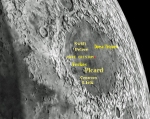 - The Moon's Mare is a land feature you don't want to miss during September. NASA Photo.
Focus your time machine to the stars on the features along the Moon's limb during the month of September. This is a rare chance to view a few limb sections of the Moon that star gazers have dreamed of taking a closer look at for generations, during a single month of the year. Astronauts didn't report any green cheese, so our ancestors can rest safely, as we have ruled out green cheese as the main ingredient in the physical composition of the Moon.
Watch as the crescent Moon waxes, between September 11 to 13, and take a close look at Mare Crisium, and how far this feature is from the eastern edge. The features on the limb that you'll notice will be the elongated dark patches of Mare Smythii and Mare Marginis. The regions near the south-eastern limb will feature primarily bright highlands that will slowly change as the 18 of September approaches and the mottled Mare Australe rotates into view.
Focus your time machine to the stars on the hilly south polar region a few nights later and you'll see nice 3D effects that catch-the-eye of the viewer and Mare Smythii and Mare Marginis will have disappeared from view.
A Full Moon will greet star gazers on September 23 and this is the perfect time to take a look at some of the best features on the Moon's surface. Mare Orientale will appear along the Moon's western limb on September 23. A magnificent impact basin, with multiple visible rings and lava lakes, get your timing right over the next few nights, and you'll witness a scene few humans have experienced. Watch patiently and you'll see the rings appear in profile first. This scene will slowly change as the Moon's libration and the rotation of the Earth bring the lava pools of Lacus Veris and Lacus Autumni into view.
Posted by Warren Wong. Posted In : the Moon
November 18, 2010
Journey to Red and Orange stars in September's night sky
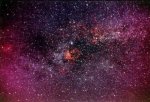 - Color like this only grows and expands the further you travel on your Journey to the Beginning of Space and Time
Fall is in full bloom in the Northern Hemispheres of planet Earth and lovers of the reds, oranges, and bright reds on the leaves of fall will enjoy the rich, warm and colourful hues in the night sky of September and October.
If you're heading out into the wild to enjoy Mother Nature's bounty at this time of year? After the day walking through the forest watching the leaves on the trees turn color, from drab green to mixed shades of yellow, orange, and red. Take the time to lay back on the cold ground or your sleeping bag and check out the colors in the night sky. Even better, set up your binoculars or time machine to the stars, and enjoy the colors in the night sky by taking a journey to the beginning of the universe.
Star gazers have witnessed the colorful displays in the night sky for generations and our ancestors surely spent many a night staring upwards in wonder at the various colors they could see in the night sky. It was 19th-century Irish astronomer John Birmingham, who first made note of the colorful hues of light in the night sky. His ideas and the thoughts of Danish astronomer Hans Schjellerup, who had compiled a catalogue of red stars in 1866, were mentioned in Birmingham's work "The Red Stars: Observations and Catalogue". This catalogue contains a total of 658 red and orange stars colorful enough to delight the human senses and make your imagination dance a lively step.
Reading the introduction of Birmingham's catalogue of red and orange stars, one notes he mentions a region of space and time he refers to as "The Red Region". This region includes parts of the Milky Way Galaxy, between Aquila, Lyra, and Cygnus, that are filled with orange and red stars that will make the eyes dance and entice the human imagination to create possibilities beyond anything we as humans have imagined.
September is the perfect time for you to board your time machine to the stars and journey to the beginning of the universe to experience the Red Region. The Red Region will be well above the southern horizon, once the sun goes down. This region of space and time has eye-gems for star gazers to view in September, with reds and oranges that will make lovers of fall smile, and turn up their color sensitivity. The colorful stars in the Red Region warm sequentially through spectral classes: G (yellow), K (orange), M (red) and rare carbon class C (deep red). Astronomers have subdivided star classes from 0 to 9, with a G9 star being a little closer to orange, than yellow, and a K5 star having a color somewhere between orange and red.
All star gazers will see varying hues of red, orange, and yellow during their journey to the beginning of the universe that will depend on each star gazers own particular biology. In fact, we all view color slightly differently, so individual star gazers shouldn't rely on a star's spectral class for a visual clue to a star's true color. Take for example, the strikingly colorful, double star Albireo (Beta Cygni) in Cygnus. Star gazers through the centuries have described its magnitude 3.1 K3 primary star as yellow, topaz, gold and orange. Its magnitude 5.1 B9 (blue-white) secondary star (34" away) on the other hand, has been described as deep-blue, azure, sapphire and even green.
The perception of color for humans is subjective and depends on varying individual parameters that can also be a product of physiological and psychological effects, such as the strong contrasting colors of a double star, like Albireo. The colors star gazers view through their time machine to the stars can also be obscured by dust and pollutants in the air, which will redden a stars color. Stars that are low on the horizon, in comparison to higher stars, will also appear redder to viewers, just like the sun turns redder as it falls toward the horizon.
Posted by Warren Wong. Posted In : the night sky
November 13, 2010
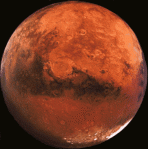 - Where did all the water go? What water? NASA photo.
More evidence for the case for the presence of water on the Red Planet
Planetary scientists taking a second look at a Mars outcropping first examined by NASA's Spirit Mars Rover back in 2005 think there could be additional evidence for water on large areas of Mars. In specific, planetary scientists have found high concentrations of carbonate, a mineral that scientists have previously shown to originate in wet conditions that dissolves in acid. This leads planet scientists to the conclusion that ancient oceans on Mars couldn't be acidic and could therefore have been favorable environments for the evolution of life forms.
This is hardly news as planet scientists have noted the presence of carbonates on the surface of Mars previously, and there could be all sorts of natural ways to produce the carbonates that we humans haven't experienced, yet. Reports indicate that scientists are finding rock outcroppings with as much as 25 percent carbonate by weight. This is a far higher percentage of carbonate than previously recorded, though, and this data could indicate the presence of vast oceans on the surface of the Red Planet in the past, according to some scientists.
One group of planet scientists in Boulder, Colorado has been studying the possibility that oceans of water once existed on the Red Planet. Gaetano Di Achille and Brian Hynek have been taking a close look at 52 martian deltas and about 40,000 river valleys on Mars, using the combined data from a series of orbiting Mars missions, conducted over years. Their studies lead them to speculate that broad and deep expanses of water once covered up to one-third of the surface of Mars, 3.5 billion years ago.
This team of astronomers concluded that at least half the deltas and river valleys they studied likely marked the boundaries of an ancient sea. The geological features in question are all at the same relative elevation, which implies they were possibly connected to martian seas or large bodies of water, according to this team of scientists.
The volume of water scientist are talking about once existing on the Red Planet is around 30 million cubic kilometers of water, about 10 times less than the volume of water contained in Earth's oceans. This study appeared online on June 13 in Nature Geoscience.
John Carter and a team of scientists at the University of Paris, on the other hand, claim that the Red Planet certainly once had vast quantities of water, only not in the form of vast seas and oceans. This team found hydrated silicate minerals within craters on the northern lowlands of the Red Planet, a place where these minerals hadn't previously been found. This fact, combined with previous indications of hydrated silicate minerals in Mars Southern Hemisphere, leads this team of scientists to conclude that Mars was changed on a global scale by liquid water around 4 billion years in the past. This group of astronomers used NASA's Mars Reconnaissance Orbiter to look inside 91 impact craters where asteroids have exposed ancient marine material several kilometers beneath the surface of Mars. They found nine contained phyllosilicates or other hydrated silicates, minerals that scientists know form in wet environments.
The real question now is, where did all this water go? Future missions to the Red Planet will be looking for facts to help determine where all the water went or if it might still might exist on Mars, in another form. They'll also be taking a close look at river deltas, which could be excellent regions to search for evidence of past Martian life.
Posted by Warren Wong. Posted In : Mars
|
Author
Warren Wong
Prince George, British Columbia
|
 Photo courtesy of NASA
Photo courtesy of NASA










